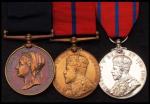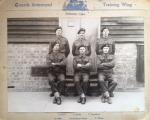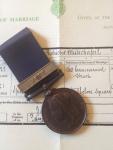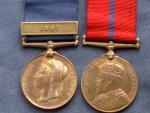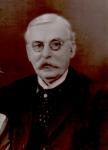-
Posts
15 -
Joined
-
Last visited
Profile Information
-
Gender
Male
-
Location
South West, UK
-
Interests
Gloucestershire Police medals and Metropolitan Police H division medals.
Recent Profile Visitors
1,127 profile views
Insp43519's Achievements
-
Hi, I am researching a man who served in the L.C.C.M.F.B. which then became the London Fire Brigade and have obtained a copy of his service record. It states he was entitled to the following medals: 1) 1897 Jubilee medal 2) 1902 Coronation medal 3) 1911 Coronation medal 4) Long Service medal (Awarded on 16/07/1904) I know his 1911 medal is a London Fire Brigade version, can anyone tell me did they release a Fire Brigade version of the 1897 Jubilee and 1902 Coronation medals? If so does anyone have any images please? Also does anyone know what the Fire Brigade Long Service medal looked like in 1904 and would it have been named or numbered? Thanks, Jon
-
1897 METROPOLITAN POLICE JUBILEE MEDAL: PC. C. SMITH. H. DIV (CID) 1902 METROPOLITAN POLICE CORONATION MEDAL: PC. C. SMITH. H. DIV (CID) 1911 METROPOLITAN POLICE CORONATION MEDAL: PC. C. SMITH (H DIV CID) CHARLEY SMITH was born on 07/03/1865 in Hannington, Northamptonshire, having worked as an agricultural worker he joined the Metropolitan Police on 27/06/1887 with the warrant number: 72728. He was posted to their H Division (Whitechapel), given the uniform collar number: 135.H, and was stationed at H Division's Commercial Street Police Station. Whilst living in quarters there he appears on the census and electoral rolls between 1891-1895. Having joined Whitechapel Division the year prior to the 'Jack the Ripper' killings he would have certainly been personally involved in the hunt for The Ripper on his normal patrols, and extra duties, expecially as he was showing an interest in a future with the Criminal Investigations Department (CID) through the period of the killings. Who knows, maybe seeing Abberline and his men at work helped decide Charley's future career path onto the Whitechapel CID. On 30/01/1888 Charley gave his first evidence at The Old Bailey Court, after chasing and arresting a burglar in Spelman Street, Whitechapel. He went on to give evidence at The Old Bailey on a staggering 21 seperate occassions, his cases ranged from burglary, theft, robbery, extortion, counterfeit currency, and receiving stolen goods. Every crime had been committed within the 1, 1/4 mile square of Whitechapel, and many of them within the infamous Whitechapel Public Houses. On 08/10/1894 Charley was promoted to rank of Detective Constable onto the Whitechapel CID, and was stationed at the Divisional HQ at Leman Street. Once there he would have been one of only 7 Detective Constables, who worked under the direction of a Detective Inspector and 8 Detective Sergeants. On 22/04/1898 Charley married in Northamptonshire, and he and his new wife moved into 20 Walden Street, Mile End Old Town, (Just off the Whitechapel Road). On 16/12/1901 Charley was Highly Commended by the Judge at The Old Bailey Court for his part in arresting 3 dangerous members of a notorious London criminal gang, who were wanted for many crimes all over London. He was commended alongside his Detective Inspector, Frederick Wensley, and his Detective Sergeant, Benjamin Leeson, both of which were later to be shot during the SIEGE OF SIDNEY STREET. On 3rd January 1911 the famous siege of Sidney Street commenced, after police attended at 100 Sidney Street to arrest members of a gang wanted for the murder of 3 City of London police officers the month before. Divisional Detective Inspector Frederick Wensley of H Division CID knocked on the front door whilst accompanied by a number of Whitechapel Detectives (Including Detective Sergeant Benjamin Leeson) during the siege both of these Detectives from Whitechapel CID received gunshot wounds. As Charley was a long serving and respected Detective of the same CID office, had worked very closely with Wensley and Leeson, and was living only 3 roads away from Sidney Street, I have no doubt Charley would have been in Wensley's team of Detectives who approached the front of 100 Sidney Street, and went on to be involved in the infamous seige. Charley Smith served his entire career of 25 years and 4 days with the Metropolitan Police on their Whitechapel Division, and 18 years of which was on it's CID. It is very rare to find medals to a man who stayed on the same Division for his entire career, especially as that Division was the famous 'H' which was involved in so many high profile cases during his time of service. Charley resigned from the service on 01/07/1912 to an annual pension of £56,12,4. He moved with his wife back to his birth place of Hannington in Northamptonshire, and stayed there until his death on 13/09/1945 (aged 80 years). Charley's full size original group of medals are now framed alongside a matching original trio of minatures, against a backing of a detailed street map of Whitechapel, London, dated 1888. (He was 7 days short of receiving the 1887 Jubilee medal, as he joined on 27th June 1887, and the Jubilee took place on the 21st!, so his group was almost a trio with 1897 bar!) 1887 medal was issued as a Uniformed Constable on H Division (One of 287) 1902 medal was issued as a Detective Constable on H Division (One of only 9) 1911 medal was issued as a Detective Constable on H Division (One of approx 12) A lovely trio to a real hard working and busy 'Commended' Victorian copper, who would have been a very familiar face on the streets, and in the pubs and lodging houses of Spitalfields, Whitechapel, London.
-
Thank you Brian, I know what you mean about Whitechapel, the reason I collect is because the Victorian period is my favourite era and out of all the divisions of the Met, I concentrate on Whitechapel as it was a very busy poor area with a very high crime rate, and obviously has had it's fair share of notorious crimes such as the Ripper killings and the Siege of Sidney Street etc.. Jon
-
Hi Alex, I have the above 1887/97, a 1897 trio to a career H Div Constable who joined in 1889, the 1887/97 & 1902 pair to a Station Police Sergeant who joined H Div in 1895, and my favourite which is a 1897 trio to a career Detective who served all his service on H Div with lots of research, he missed out on the 1887 medal by 2 weeks as he joined in 1887. Always looking for others to add too Jon
-
1939-1945 Star: Unnamed as issued France & Germany Star: Unnamed as issued Defence Medal: Unnamed as issued War Medal: Unnamed as issued Royal Life Saving Society Bronze Medal: G.D. HICKS, JUNE 1939 (With RLSS bar and named 1940 bar) GORDON D. HICKS was born during 1925 in Westbury on Severn, Forest of Dean, Gloucestershire, where his father was Pc Gordon W. Hicks of the Gloucestershire Constabulary. He followed in his father's footsteps and in 1940 he joined the Gloucestershire Police Auxiliary Messenger Service in Cheltenham, as he lived with his parents at 32 Shakespeare Avenue, St Marks. His name appears in a local newspaper in 1939 for being awarded the RLSS Bronze medal in Cheltenham, he was later awarded a bar for it in 1940. In September 1942 he was awarded a 2nd bar from the RLSS but he was not issued it due to the war time metal shortage, and was just given a token to swap after the war for the bar. The same month in 1942 he passed the RLSS first class instructors course all whilst serving in the Cheltenham Police. Then in December 1942 he was given the RLSS award of merit certificate in the police. (All original certificates, patches and badges are with the medals). In 1943 he enlisted with the Army and went into 2nd Battalion Welsh Guards, during February 1944 he conducted training with the Guards Armoured Division and is in a group photo at the training wing. He then went with his Battalion to France and landed at Normandy on 26/06/1943. He would have been engaged in such Operations as Goodwood and Bluecoat and went on to liberate Brussels in September 1944 as part of Operation Market Garden, they then led the spearhead attack into Holland. I strongly suspect he was a member of the Recce / scouting force of the Guards Armoured Division. 20 year old Guardsman Hicks was injured in April 1945 whilst fighting in the European Theatre of War, admitted to hospital due to receiving a shoulder injury and shock, the story was reported on the front page of the Cheltenham Chronicle and Gloucester Graphic on 12/05/1945, including his photo which matches his image from the training wing photo in 1944.
-
1887 Metropolitan Police Jubilee medal: PC G. POYNTER H DIVISION (WHITECHAPEL) 1897 Metropolitan Police Jubilee bar to above: PC G. POYNTER H DIVISION (WHITECHAPEL) GEORGE ELLIOT POYNTER ('GINGE') was born during 1866 at Birtland, Ringwood, Hampshire, the son of William Poynter a Police Constable. By 1881 George was living with family at 11 Mill Cottages, Freefolk Manor, Whitchurch, Hampshire, aged 15yrs he was employed as a paper maker. On 9/7/1883 he joined the Metropolitan Police with the warrant number 68351 and was posted to R (Greenwich) Division, but by 1885 he had been transferred to H (Whitechapel) Division, and given the collar number H.206 He was a commended Police Constable in the Borough and his name appears in many London Newspaper articles, such as: 17/10/1885 - Arrest of a drunk unfortunate woman with 200 previous drunk charges, given 1 month hard labour. 25/12/1887 - Arrest of a man breaking into the White Swan Pub, Mansell Street, Whitechapel. 23/03/1890 - Arrest of a famous boxer 'Sugar Goodson' for disorderly conduct in Hanbury St, Whitechapel, when arrested he ripped the officer's cape. 19/07/1891 - Discovered a deceased unfortunate woman on the floor in Thrawl Street, Whitechapel. 16/10/1892 - Arrested a Royal Marine 'deserter' wanted in the Hue & Cry gazette. 13/03/1897 - Commended by court for brave arrest of man armed with pistol following a street robbery in Commercial St, Whitechapel. 20/03/1898 - Commended by coroner for saving lives from a house fire at 117 Hanbury St, Whitechapel. He also gave evidence at The Old Bailey on 3 occasions: 08/09/1896 - Arrested suspect for robbery in Commercial St, Whitechapel (Referred to by the suspect as 'Ginge' in court). 08/03/1897 - Arrested suspect for robbery and recovered a loaded revolver in Church Street, Whitechapel, (Referred to by the suspect as 'Ginger' he clarified for the court he was known by locals as 'Ginge'). 07/01/1901 - Gave evidence as an insurance clerk in a deception case (After leaving the Police). On 08/01/1889 George married Julia Harris, a tailoress from Wellclose Square, Whitechapel, they married at the Whitechapel Registry Office. On his marriage certificate George gave his address as The Police Station, 160 Commercial Street, Whitechapel, London. Seeing as his 1887 medal has H Division on it, this proves he was a Policeman walking the streets of Whitechapel whilst 'Jack the Ripper' was actively killing prostitutes on his beat. George and his wife went on to have 10 children whilst living in the Borough of Bethnal Green. Sadly things went very wrong for George Poynter whilst on night patrol during 21/06/1898. He crossed over from his designated beat and went to Newman's Court, Cox's Square, Whitechapel. There he was seen by a witness to lean over a wall and steal a bird cage containing a canary. He took it home and when later challenged about the theft he claimed he found it and forgot to hand it in, due to being tired. He was charged with theft and breach of duty, he appeared at Worship Street Court on 02/07/1898. He was found guilty of breach of duty and fined 40s and 40s costs. Inspector Taylor of H Division spoke on his behalf and stated that although Constable Poynter had some reports against him (3 serious, one on 12/05/1892), but during his 15yrs service he had been commended on 8 occasions and rewarded once. Due to this, Poynter was dismissed from the Police on 25/06/1898 and his story made the front page of The Illustrated Police News, titled - THE POLICEMAN AND THE CANARY! He remained with his wife and family living in Bethnal Green and had a number of jobs, such as a commission agent for an insurance company, a time keeper at the wharf and a night watchman for the Borough Council. He passed away on 22/07/1925 at Cambridge Road, Bethnal Green, aged 59, whilst his address was registered at 1 Cordova Road.
-
It's about time I posted something, seeing that so many members have helped me in the past, so when these came through my door today I thought I would share them with you as my latest medal addition: 1887 Metropolitan Police Jubilee medal: PC R. STAFFORD P DIVISION (CAMBERWELL) 1897 bar to the above medal: PS R. STAFFORD H DIVISION (WHITECHAPEL) 1902 Metropolitan Police Coronation medal: PS R. STAFFORD H DIVISION (WHITECHAPEL) RUSSELL GUNNING STAFFORD was born on 1/10/1864 at Short Street, Ditton Marsh, Westbury, Wiltshire, and was the son of a local farmer. By 1881 he had moved to Somers Street, Portsea, Hampshire where he worked as a grocer's shopman and lodged above the shop. The following year he married Clara Conrad a music seller in Portsea, then on 23/2/1886 he joined the Metropolitan Police. His warrant number was 71307 and he went onto P Division (Camberwell). He gave evidence at The Old Bailey on 30/01/1888 in a deception/forgery trial and his collar number then was given as P.387. By 1897 he had transferred to H Division (Whitechapel) where he had been promoted to the rank of Sergeant and lived with his wife in Exmouth Street, just off the Commercial Road. On 20/04/1909 he again gave evidence at The Old Bailey in a deception/fraud trial, but this time he is recorded as Police Sergeant, H Division Warrant Officer - Thames Police Court (Which is a new rank on me, did every Court have a warrants Sergeant I wonder?) He remained in Whitechapel until his retirement on 27/02/1911 whilst serving as a Station Police Sergeant. He passed away on 12/3/1937 at 41 Ben Jonson Road, Stepney, London. The below photo of him is on the Stafford family tree on Ancestry.com Regards, Jon





